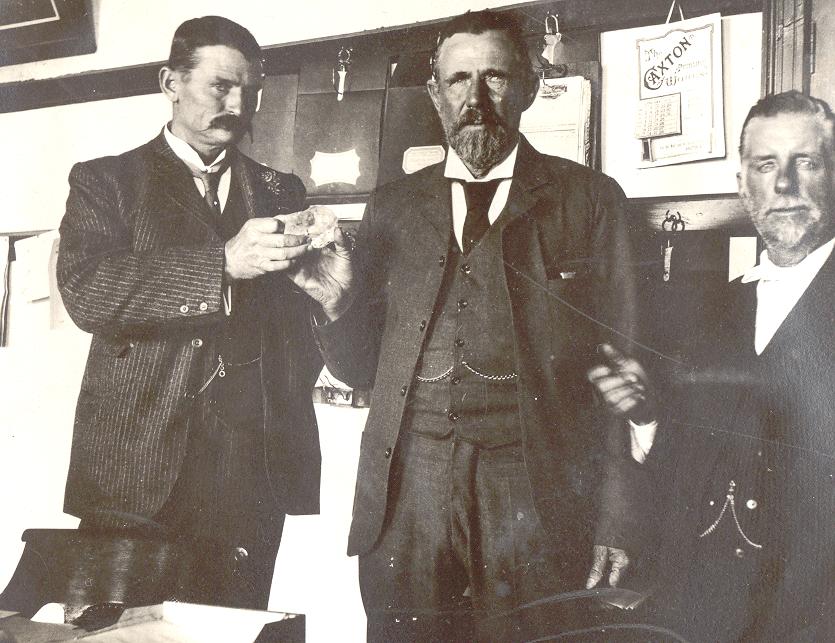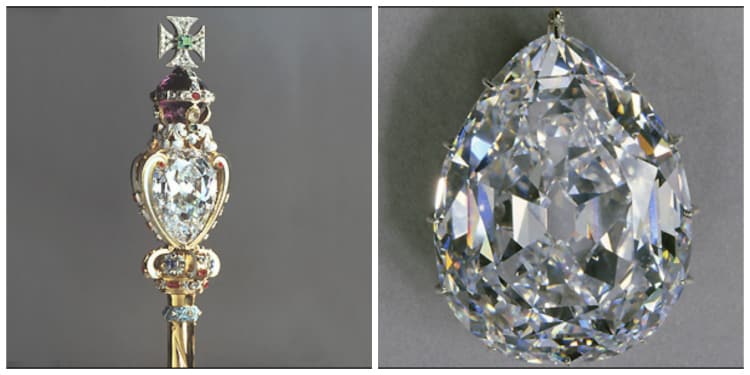It was the late afternoon of January 25, 1905. Employees at the Premier Diamond Mine in the British African colony of Transvaal were finishing up for the day when their routine was shattered by an animated worker hurriedly approaching the mine superintendent, Frederick Wells. Blathering incoherently, the excited worker-led Wells back to a large hole in the ground and pointed to something sparkling protruding from one of its walls. Climbing down into the hole, Wells dug the object out and held in his hand what is to this day the largest gem-quality diamond ever to be found; The Cullinan Diamond.

Measuring in at 2 x 2 x 4 inches and weighing near a staggering 1 1/3 pounds or 3,106 carats, this almost flawless rough diamond was named for Sir Thomas Cullinan, the founder of the Premier Mine who, by unknown circumstance, was lucky enough to be visiting his mine on that eventful day. Some two years later the Transvaal Colonial Government – seeking an impressive PR gesture – bought the stone for about one million dollars and presented it to King Edward VII on the occasion of his 66th birthday and as a thank you for granting Transvaal its own constitution.
Now the owner of this extravagant gift, a most certainly overwhelmed King Edward VII was left with the daunting task of choosing a cutter for this record-breaking diamond. Remembering who was responsible for the largest successful diamond cut prior to the Cullinan – the 995 carat Excelsior. His Majesty awarded the task of tackling this new discovery to Amsterdam’s House of Asscher. With their reputation hanging in the balance, Asscher’s expert cutters spent months using glass and wax models to repeatedly practice for the big day. They were also forced to modify tools and equipment at their facility to accommodate this oversized gem. On February 10, 1908, at 2:45 in the afternoon, Asscher placed a steel blade into a groove previously cut into the diamond, raised his steel rod and gave the blade a solid whack. Nothing happened. On the second try the diamond cleaved as planned. There were rumors of Asscher fainting and being hospitalized, but a family member was quoted as saying “No Asscher would faint over any operation on a diamond.”

From Asscher’s cut, the Cullinan Diamond created a family of nine major and ninety-six minor diamonds leaving about 19.5 carats of unpolished pieces. Asscher kept all but the two major stones as payment for his work. King Edward bought one of the larger stones for his consort, Queen Alexandra. In 1910 the Transvaal government bought the remaining stones and pieces. From that collection, the Transvaal government presented the six major stones to Queen Mary, consort of George V in 1910. Those six, along with the one from Queen Alexandra, remain with the estate of Queen Elizabeth II. Louis Botha, Premier of the Transvaal Government received two of the smaller stones. As for the remaining pieces, no one knows what became of them.
The two largest cut stones became the famous First and Second Star of Africa. Both were retained by Great Britain for use in the British regalia. The First Star of Africa, weighing in at an impressive 530 carats, became the largest cut diamond in the world. To this day it can be seen on display in the Tower of London, along with all of the British Regalia, and during the coronation of a British King or Queen. Part of this ceremony has the Sovereign invested with two objects, the Sceptre with the Cross and the Sceptre with the Dove. It is this Sceptre with the Cross – originally made for the Coronation of King Charles II – that was re-designed in 1910 to hold the First Star of Africa.

Cullinan I or First Star of Africa – Sceptre with the Cross.
Photos Courtesy of the © Crown Copyright.
Its smaller sister, the Second Star of Africa, weighs in at 317 carats and is set into the front of the Imperial State Crown, worn by the sovereign upon leaving Westminster Abbey after coronation and also on major State occasions. It is positioned just under the famous “Black Princes Ruby” (discovered to actually be a spinel) in the band of the crown. Both diamonds can be removed from their respective regalia and clipped together to be worn as a brooch. The wife of King George V, Queen Mary, liked to wear them in this fashion.
The Cullinan still holds the title of the largest gem-quality diamond ever found. The nine major diamonds cut from the Cullinan are as follows:

Top Row: II, I and III. Bottom Row: VI, VIII, IV, V, VII and IX.
Cullinan Diamonds
| Shape | Carat Weight | Name | |
|---|---|---|---|
| 1 | Pear-Shape | 530.20 carats | The First Star of Africa |
| 2 | Cushion-Shape | 317.40 carats | The Second Star of Africa |
| 3 | Pear-Shape | 94.40 carats | Cullinan III (Third Star of Africa) |
| 4 | Square-Cushion | 63.60 carats | Cullinan IV (Fourth Star of Africa) |
| 5 | Heart-Shape | 18.50 carats | Cullinan V |
| 6 | Marquise-Cut | 11.50 carats | Cullinan VI |
| 7 | Marquise-Cut | 8.80 carats | Cullinan VII |
| 8 | Rectangular-Cushion | 6.80 carats | Cullinan VIII |
| 9 | Pear-Shape | 4.39 carats | Cullinan IX |